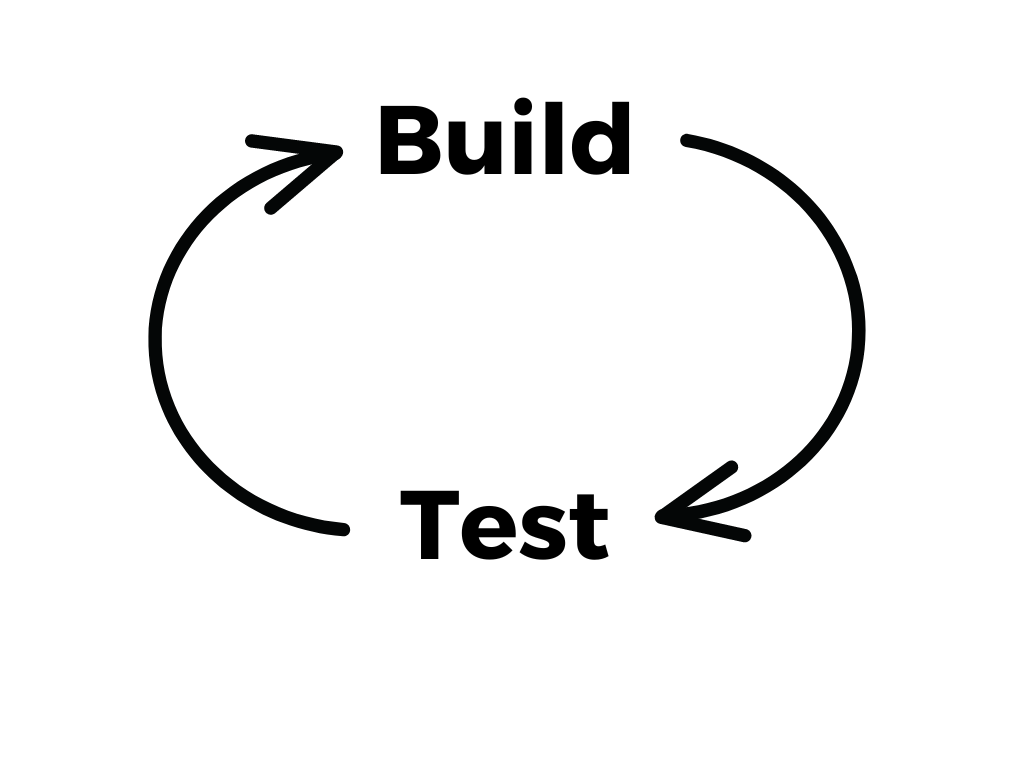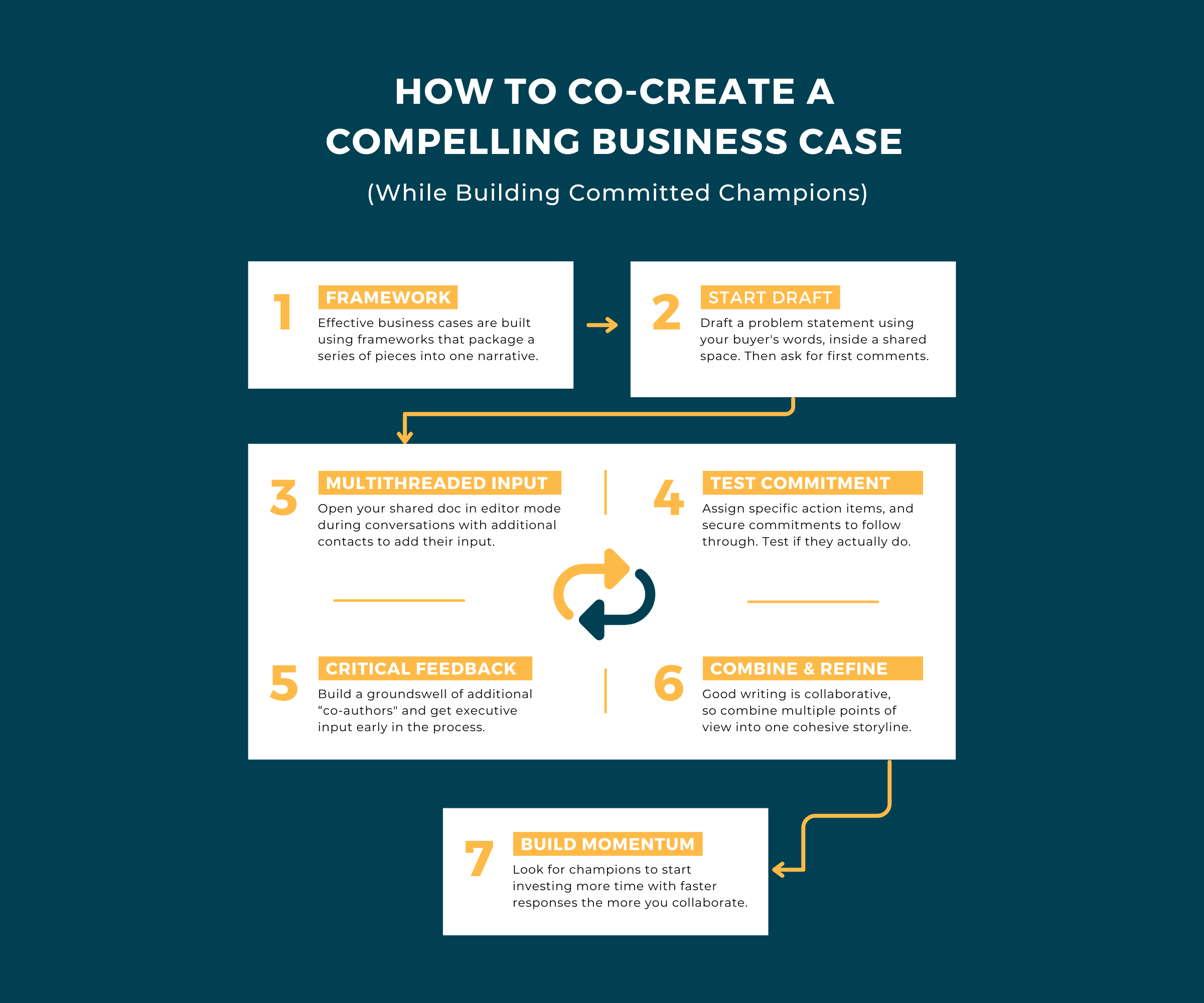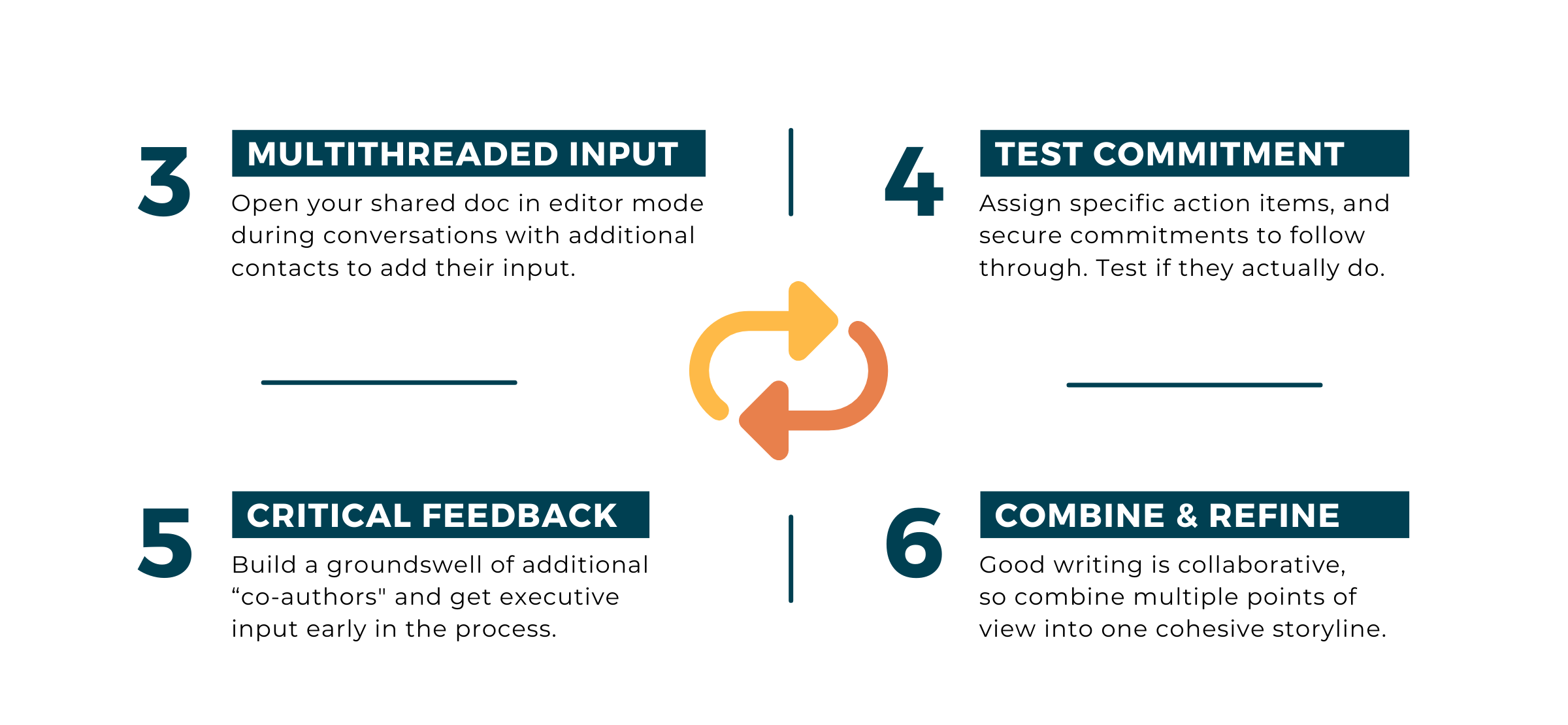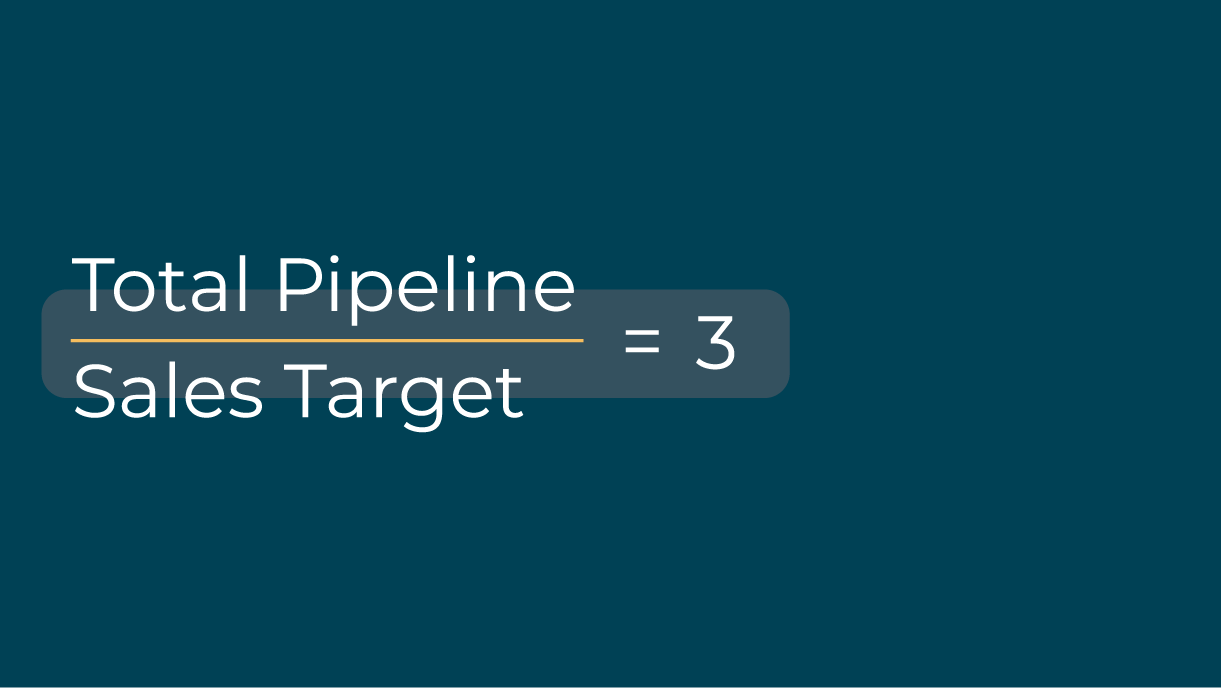The Build Loop: Create Insanely Committed Champions by Co-Creating a Compelling Business Case
.png)

Let’s start with a simple thought experiment.
Say you’re on a forecast call. You're looking at two deals in the same stage. Your VP asks, “Which deal are you more confident will close?” You think about the champions in each deal:
- Champion #1: They’re attached to your deal, but it’s more like velcro.
Things have been pretty smooth so far. So if the buying team continues to along go with the deal, your “champion” will too. But if you hit too much friction, your deal will come apart. Your champion’s not that attached.
- Champion #2: They’re attached to your deal like steel parts welded together.
It feels like they’re strangely obsessed with your deal. Almost like they’ll quit — just up and walk off the job — if you lose this deal. The only way they let your deal come apart is if some major shakeup happens.
There’s a pretty straightforward answer here. Obviously, deal #2 is where you'll place your bet. It’s almost a sure thing. But also notice:
- It’s the seller’s deal to lose in #1. They have more at stake. But it feels more like the champion’s deal to lose in #2.
- Deal stages can be misleading. The only way to truly look at deal “quality” is your champion’s buying behaviors.
- Most people use “champion” as a catch-all term. But clearly, not all champions are created equal. There are varying degrees of commitment.
So the question we end up with is:
How do I make sure all my deals look like the second? Quality deals, with insanely-committed champions.
The answer comes down to the "Build Loop." And what IKEA figured out.
Building Champions like IKEA Furniture
There’s a cognitive bias called the “IKEA Effect.” It says we assign far greater value to the things we build, than what we buy or others build for us.
In short, we all take a stake in the things we create.
Slowly and overtime, a weird and irrational sense of attachment grows on us. That bunk bed that took you 4 hours, 98 bolts, and 768 twists of a tiny Allen wrench that left your fingers dented?
You wouldn’t sell it for anything less than $600, even years later. (Though someone in their right mind would only pay $200.)
The IKEA effect is something you need when building champions too.
If the buying process becomes too “white glove,” it’s counterproductive. You’ll reduce your champions’ sense of ownership, and believe your deal’s more qualified than it actually is.
Instead, your champions’ fingerprints should be all over the solution you’re creating together.
It should look and feel like their creation — not yours. Yet most reps take the opposite approach.
Instead of writing and creating, they rely on the classic enablement decks. Which look and read like big product billboards. They present pre-packaged, ready-made solutions*.
(*Note: a “solution” is far more than a product. It’s the sum of all the problem discovery, consensus building, onboarding, adoption, etc. Which means solutions can’t exist without champions. Remove them, and you’re left with a product. But take a motivated champion and you can, in fact, remove the seller and get a deal done.)
A Virtuous Cycle: The Build Loop for Creating & Enabling Champions
The beautiful thing about building and enabling champions is both steps work together.
There's a type of self-reinforcing loop as you work to...
- Build committed champions
- Build a compelling business case
...you’ll find that:
- Creating champions helps you build a stronger business case.
- Co-creating a business case helps you build stronger champions.
And these two steps repeat over and over in a virtuous cycle. Helping you to:
- Increase the level of ownership your champions feel.
- Test whether you’ve built a true champion. Which is always based on evidence.

So the next question is, how do we design buying experiences with a Build Loop?
Is there a process — an IKEA instruction manual, if you will — that we can follow?
Do I love dark chocolate? Yes. Very much so.
A Step-by-Step Guide to Building Champions (By Building a Business Case)
Here's your high-level instruction manual:

Let's break this down one step at a time.
1/ Start with a solid framework in mind.
Effective business cases package together a set of different pieces into a single narrative:
- Enticing headlines
- Sharp problem statements
- Compelling, unique approaches
- Bold visions with specific outcomes
- Clear investment and rollout plans
When you kickoff your first discovery call with a specific framework in mind, you know how to structure your conversations. You have a clear vision for the end product. So you can set about discovering and assembling each piece.
2/ Start with a few simple sentences, in a shared space.
Most sellers believe business cases are grand productions you spend months engineering.
Then, finally, to help close the deal, you whip out a persuasive and polished case for change.
That couldn’t be further from the truth.
Business cases should start with a few simple sentences. A recap of your first contact’s point of view on the problem, with some open gaps you’ll plan to fill in together.
This sounds like:
I’ll plan to build a short recap from what I understand about the main challenges we’re focused on, before of our next call with [ colleague ].
Would you be open to sharing a few comments in between now and then? To make sure I’m capturing what’s most important?
Then, drop a short problem statement, alongside a few notes, inside a shared doc.
There’s a full write-up on problem statements here. (And If you’re not already using a collaborative tool like Fluint, a Google Doc is fine.) Your goals here are two-fold:
- Encourage co-creating with a first comment — which is the hardest to capture.
Once you get that first comment in your shared space, it unlocks more collaboration. Because it’s far more engaging for a buying team to see their own colleagues are already sharing feedback and building alongside you.
It helps breaks down the “seller vs. buyer” wall, and shifts the posture to a team effort.
- Show you know and truly understand the problem better than anyone.
This creates catharsis, and it’s powerful. So powerful, one of Fluint's earliest users has been winning $2M+ deals just based on their ability to accurately message the problem. (Their robotics product is still in the prototype phase.)
And again, don’t complicate this.
White page, black font, a few thoughtful sentences of content.
3/ Expand from your starting point with a wider circle.
A question I love here is:
Who do you typically turn to for advice when a project is important to you?
Do you think we could get their input on our project early in the process, too?
Chances are, that’s exactly the person you want to be building into a lead champion. They carry influence. Start involving them in your next calls by:
- Pulling up the shared doc you started.
- Sharing your screen with the doc in editor mode.
- Ideally, you'll have a few comments from others shown inside.
- Gather their input and leave more comments with updates as you’re talking.
You’ll say something along the lines of:
Here’s what we’ve captured so far, and I’m wondering two things from your perspective:
What resonates, that you think we should highlight? And what do you think we’ve missed?
Even better? Cue up your first contact to share their point of view, with the doc to guide them:
[ Contact #1 ], would you be up to share your summary with [ Contact #2 ] to start us off?
As you repeat this with a wider group of contacts, you should see your champions growing more animated. Speaking with more conviction.
4/ Assign specific action items and secure commitments.
This is where we start to come back to the IKEA effect, while running some tests. Start to ask for commitments to continue collaborating in between conversations:
- Look for gaps in your framework (e.g. you need data for the baseline in "outcomes").
- Assign tasks to fill in the gaps (e.g. work with Sales Ops to find win rates by segment).
People make time for the tasks that are a priority for them.
Which makes this one of the more effective tests you can run to validate if, in fact, you’re building a strong a champion. Do they follow through on what they commit to?
Another strategy I like is adding in placeholder data and saying:
No doubt I’m off base here, but I added in some placeholder data. Who do you think we should work with to update this?
Generally speaking, people can’t help but correct what they think is inaccurate.
5/ Socialize your narrative and look for critical feedback.
When your narrative is still in a draft state, but far enough along there’s a complete storyline, guide your champions in socializing it:
- Design your account maps based on the ideal flow of internal communications.
- Go deep on where and how. Which meetings will they bring your narrative into? Are you the full meeting agenda? Just a line item? Who needs to be there?
Your goals here are to:
- Strengthen the message. Find people willing to disagree and poke holes in the message.
- Build a groundswell of additional “co-authors.” A petition for change is only as strong as the number of signatures it gathers.
- Seek executive feedback early. The contacts who will greenlight your budget should hear your narrative multiple times, well in advance of making a decision.
This step is core to the Build Loop because:
- Once you’ve pushed your chips into the center of the table, you’re all in. Champion relationships only grow after they start advocating for your business case.
- The willingness to put your social capital behind a project is a strong signal you’re passing "behavior-based" champion tests with flying colors.
6/ Combine additional feedback & refine your narrative.
Copywriting and advertising legend David Ogilvy has a list of 10 hints for writing well. Three of them include:
- Never write more than two pages on any subject.
- If it is something important, get a colleague to improve it.
- Never send a letter or a memo on the day you write it. Read it aloud the next morning—and then edit it.
Similarly, Jeff Bezos, who built a strong writing culture inside Amazon, said:
The great memos are written and rewritten, shared with colleagues who are asked to improve the work, set aside for a couple of days, and then edited again with a fresh mind.
He also said:
The reason writing a 'good' four page memo is harder than 'writing' a 20-page PowerPoint is because the narrative structure of a good memo forces better thought and better understanding of what's more important than what.
Different views on the right length for a narrative, yes, but the shared themes here are:
- Good writing is collaborative. You can’t write a “good” business case by yourself.
- Good writing is clarifying what you want to say. What’s more important than what?
Both points require distilling everyone's input into a single, cohesive storyline.
7/ Look for Signs of Increasing Deal Momentum
Steps 3 - 6 will repeat in their own loop, with the total number of loops depending on the length of your cycle and deal complexity.

With each new loop, you should find that the process of co-creating:
- Increases the total time commitment.
- Plays out over shorter cycles of time.
- Is pushed forward by your champions.
When this happens, you’re on your way to a champion who’s so committed, they’ll “walk off the job” if your deal gets shut down. So, try to roughly figure out:
- How much time is my champion investing with me?
- Are they getting back to me in shorter time intervals?
- Are they the ones pushing our pace to go even faster?
If so, you know you can confidently answer any question in your next forecasting call.
I should also mention this process is way more fun than building IKEA furniture...
FAQ's on:
Why stop now?
You’re on a roll. Keep reading related write-up’s:
Draft with one click, go from DIY, to done-with-you AI
Get an executive-ready business case in seconds, built with your buyer's words and our AI.

Meet the sellers simplifying complex deals
Loved by top performers from 500+ companies with over $250M in closed-won revenue, across 19,900 deals managed with Fluint

Now getting more call transcripts into the tool so I can do more of that 1-click goodness.



The buying team literally skipped entire steps in the decision process after seeing our champion lay out the value for them.


Which is what Fluint lets me do: enable my champions, by making it easy for them to sell what matters to them and impacts their role.








